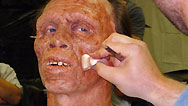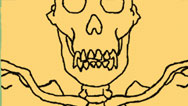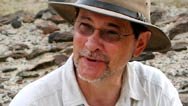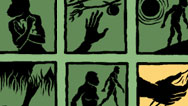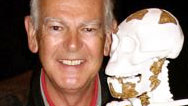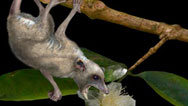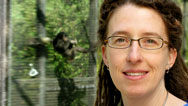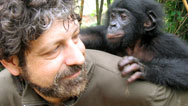
Becoming Human Part 2
Birth of Humanity: New discoveries reveal how early humans hunted and formed families. Airing August 31, 2011 at 9 pm on PBS Aired August 31, 2011 on PBS
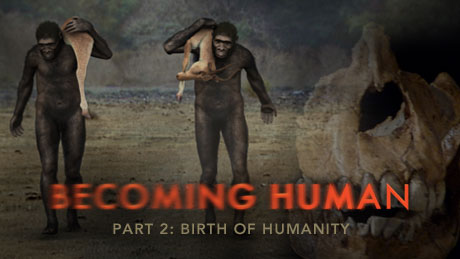
Program Description
Transcript
Becoming Human – Hour 2
PBS Airdate: November 10, 2009
NARRATOR: Humans: without a doubt, the smartest animal on Earth. Yet we're unmistakably tied to our ape origins. Millions of years ago, we were apes, living ape lives in Africa. So how did we get from that to this? What happened? What set us on the path to humanity?
The questions are huge. But now there are answers.
At the threshold of humanity, one ancestor contains tantalizing secrets. It is known as Homo erectus.
RICHARD WRANGHAM (Harvard University): Homo erectus had a slightly smaller brain, slightly bigger jaw, but it's basically us.
NARRATOR: Basically us, almost 2,000,000 years ago.
New finds are revealing the truth about the ancestors at the heart of our evolution. Here were the trailblazers who first left Africa: the first fire makers, the first hunters.
JOHN SHEA (Stony Brook University): These creatures were capable of analyzing possible uses of tools and coming up with a technological solution to the problem: how do you kill a big, dangerous animal without getting killed yourself.
NARRATOR: Homo erectus pioneered what it means to be human, colonizing whole continents and creating the first human societies.
SARAH BLAFFER HRDY (University of California, Davis): Our ancestors began to care about what others thought and care about what that individual thought about them.
NARRATOR: Now, new discoveries are bringing them alive as never before. At last we come face to face with the ancestors at the birth of humanity, right now on NOVA.
Major funding for NOVA is provided by the following:
I've been growing algae for 35 years. Most people try to get rid of algae; we're trying to grow it. The algae are very beautiful. They come in blue and red, golden, green. Algae could be converted into biofuels that we could someday run our cars on. In using algae to form biofuels, we're not competing with the food supply, and they absorb CO2, so they help solve the greenhouse problem as well. We're making a big commitment to finding out just how much algae can help to meet the fuel demands of the world.
To pursue the life you want, sometimes you need a financial advocate who knows where you want to go. A Merrill Lynch financial advisor, now with access to the resources of Bank of America, can help you diversify, rebalance, imagine, and believe: Merrill Lynch Wealth Management.
And by Pacific Life: the power to help you succeed; offering insurance, annuities, and investments.
And David H. Koch. And...
Discover new knowledge: HHMI.
And by the Corporation for Public Broadcasting and viewers like you. Thank you.
NARRATOR: The Great Rift Valley of East Africa. Two million years ago, these spectacular plains and canyons witnessed a mysterious event: the birth of the first ancestor we can really call human.
New discoveries are revealing a creature surprisingly like us, a world traveler, a toolmaker, a hunter, tamer of fire, creator of the first human societies.
Amazingly, the qualities that make us human began not with our own species, Homo sapiens; the true birth of humanity began much further back in time, millions of years ago.
Imagine the entire span of recorded human history, taking us back to the Egyptian pyramids, about 5,000 years. Double it: 10,000 years ago, when plants were domesticated and agriculture begins. Double it again, 20,000 years: Ice Age hunters are painting stunning images on cave walls. And keep doubling six more times: only then do we encounter our ancestor, Homo erectus, in Africa's Great Rift Valley.
For millions of years, this massive geological fault line running the length of East Africa was a stage on which our human evolution was played out.
It all started with the first apes to walk upright on two legs, about 6,000,000 years ago. There were many different types, all variations on the same theme: ape-like creatures with small brains.
The fossil known as Lucy is the most famous example. Here she is: just three-foot, eight-inches tall, with a brain the size of a chimp's.
For millions of years, creatures like her roamed the forests and grasslands of Africa. But then something changed. About 2,000,000 years ago, new creatures appeared with abilities never seen before in the animal kingdom. Meet Homo erectus, a toolmaker and hunter, one of the first members of our genus, the genus Homo, humans.
DANIEL LIEBERMAN (Harvard University): The transition to Homo was probably one of the most important transformations that occurred in human evolution.
NARRATOR: Arms got thinner, legs got longer, brains got bigger. It was a huge evolutionary step from ape bodies to bodies like ours. But what about the things that make us distinctly human? Creativity, intelligence, caring for each other; how can we know when these got started?
With only skulls and bone fragments to go on, how could we ever know what those first humans were really like? It would take a momentous find to shed light on their lives.
Lake Turkana, Northern Kenya: surrounded by volcanoes and vast expanses of baking desert.
In 1984, famed anthropologists Richard and Meave Leakey were working at this remote inland sea.
MEAVE LEAKEY (National Geographic Explorer-in-Residence): I was actually on the east side of the lake. And then Richard flew over and said, "You've got to come. There's something really exciting."
NARRATOR: As the first family of paleoanthropology, the Leakeys were used to fossil finds. But this was very special. One of Leakey's team had found a skull fragment of one of those early humans. He could tell from its size and shape it was Homo erectus. And there was more than just a fragment.
RICHARD LEAKEY (National Geographic Grantee): So we started looking at the site on a more extensive basis. And of course once we did, we found the rest of the skull.
NARRATOR: A complete skull was rare enough, but it was just the beginning. Soon parts of the Homo erectus skeleton which had never been found before, started to emerge.
MEAVE LEAKEY: We couldn't believe it, but we started getting pieces of ribs. These were the parts of Homo erectus that nobody actually knew about, nobody had ever seen before. So every bone that came out of the ground was something brand new to science. And we were looking at these things, and it was really amazing.
NARRATOR: And here they are: the actual bones of a human ancestor who lived over one and a half million years ago. It's the earliest human skeleton ever discovered.
The Leakeys called him "Turkana Boy." His bones have revolutionized our understanding of the transition from ape to human.
SUSAN ANTíN (New York University): The really important thing about Turkana Boy is how complete he is. We've got arms and legs, and bits of his spine and his ribs. And usually when we find these things, we get very excited about one little bit of bone, but that little bit can't tell us very much about an individual. So having a nearly complete skeleton, we can start to ask big questions.
NARRATOR: The first big question was, "What did he look like?"
His skeleton tells us he was five-feet, three-inches tall with a build closer to a man's than an ape's. But how close?
Paleoartist Viktor Deak specializes in painting and sculpting our human ancestors with precise anatomical accuracy.
Viktor is going to add Turkana Boy to his family of ancient faces.
VIKTOR DEAK (Paleoartist): At this stage of the game, I know that Turkana Boy is not an ape. He is a very early, true human. And so, here, we have a modern human skull. The faces are very similar to one another, but Turkana Boy's skull is a bit more primitive and has a lower forehead and a much smaller brain capacity.
NARRATOR: Viktor will build Turkana Boy's face, muscle by muscle, based on his studies of cadavers and modern anatomy.
While his head may be primitive, Turkana Boy's skeleton is surprisingly human. His hips are a little wider, his arms a little longer, but his overall body shape is just like ours.
VIKTOR DEAK: Turkana Boy and erectus, that's something that if you were to see from a hundred feet away, you would think, "Well there's a large naked man there, or woman, or...," you know? But it's a human.
NARRATOR: It will take Viktor a week to flesh out Turkana Boy's face. Meanwhile, a team of animators is at work creating scenes that will bring Turkana Boy and his people to life. To make sure they do it accurately, they have enlisted the help of Harvard anthropologist Dan Lieberman.
DANIEL LIEBERMAN: They had a more forward position of the palms when they ran, just slightly. There you go.
NARRATOR: The blue suited actors are there to create movement references for the artists.
In the final animations, they will be replaced by Homo erectus bodies...
GRAHAM TOWNSLEY (Director): And...action!
NARRATOR: ...their heads and faces based closely on Viktor's model.
As Turkana Boy's forensically reconstructed head nears completion, a face emerges that looks a lot like us. Now, for the first time in a million and half years, here he is, our ancestor, the Homo erectus called Turkana Boy.
But what he looked like is only the beginning of his story. To reconstruct his life, we need to find out how old he was.
SUSAN ANTíN: And if we look at his skeleton, we can see that the growth plates on his limbs that would fuse when he's fully adult are all unfused, so even though he's very tall, we know that he's still growing.
NARRATOR: The fact that Turkana Boy was not fully grown has turned out to be a boon to researchers.
MEAVE LEAKEY: You can answer questions like did the boy grow up like a modern human? Or did he grow up more like an ape?
NARRATOR: Turkana Boy was already five-feet, three-inches tall.
When scientists compared his bones and teeth to ours, he seemed to be about 14 years old. But when dental specialist Chris Dean began to study his teeth he was in for a shock. It turns out that all teeth, fossil or not, preserve a remarkably precise record of childhood.
CHRISTOPHER DEAN (University College London): This is a fossil tooth, and we can see the enamel cap which covers the core of the tooth, which is made of dentine. Dentine is just another word for ivory. Within the enamel you can see the rods, which are running from the enamel dentine junction, here, out to the surface of the tooth.
NARRATOR: Enamel has a regular growth pattern, like the rings of a tree. Under an electron microscope it looks like rods made of tiny beads.
CHRIS DEAN: Each of the little beads, along these prisms represent one day's growth because the cells which produce enamel are actually under the influence of a circadian, or daily clock. And those secretions during the day speed up and then slow down, and there's a permanent record of that in every tooth.
So you can see rods running all the way through this tissue and every day along the rod there is a wobble where the tissue slows down and then speeds up.
NARRATOR: So if you count the beads in these strings, you can figure out exactly how many days that tooth has been growing.
When Chris looked at the fossilized teeth of Turkana Boy, he got a huge surprise. Turkana Boy wasn't fourteen years old. He was eight.
CHRIS DEAN: What that implies is that the growth of the Turkana Boy resembled more closely that of chimpanzees today.
NARRATOR: To be five-foot-three at age eight, Turkana Boy must have grown up very fast, at a rate closer to chimps than us.
A chimpanzee's childhood is short. It is sexually mature at about seven. Human childhood is longer. We reach puberty at about 12.
So as humans evolved from apes, childhood was extended. But what advantage could be gained by having helpless children around to feed and care for, who take so long to grow up?
The mystery of prolonged childhood is at the heart of human evolution. It may be related to brain size. We humans have the biggest brains in the animal kingdom in relation to our body size. They are so big that most of our brain growth has to happen outside the womb or our heads would never get through the birth canal.
A long, slow childhood gives our brains time to grow after birth and time to learn everything we need to function in our complex human societies. That's the advantage of prolonged childhood, for us at least.
But what about Turkana Boy?
His brain was 900 cubic centimeters, smaller than ours but more than twice as large a chimp's. So was he on the way to thinking and talking like us?
Ralph Holloway believes he was. He's been collecting the brain endocasts of human ancestors for over 30 years.
An endocast is a mold taken from the inside of the skull which reveals the shape of the brain. Ralph is particularly interested in something called the Broca's area.
RALPH HOLLOWAY (Columbia University): Broca's area is involved with memory functions, executive functions, but it does have a very important role to play in the motor aspects of speech.
NARRATOR: In the brain of Turkana Boy, Ralph believes he sees evidence for something remarkable, a change in the Broca's area, tied to communication.
RALPH HOLLOWAY: Broca's caps regions on the Turkana Boy are fully modern in terms of their appearance. It is good solid evidence for the...having the ability of symbolic communication, in other words, language.
NARRATOR: It's a controversial idea, and we'll never know for sure if Turkana Boy could speak. But there are other clues to his intelligence: the stone tools he left behind.
JOHN SHEA: Homo erectus made tools like this hand ax here. It's been chipped extensively on both sides. The point enables one to do piercing tasks; the heavy bit here can be used for cracking bone or chopping wood. It's a very, very versatile tool, and a sharp one.
NARRATOR: It may not look like much, but the stone hand ax marks the birth of technology.
Homo erectus has left us many signs of his inventiveness. Here in Central Kenya, Rick Potts has been studying a treasure trove of Homo erectus stone tools.
RICK POTTS (Smithsonian Institution): Stone tools represented a momentous change, because once you had tools in your hands, all the foods in the world could open up to you. That represented a tremendous survival advantage.
NARRATOR: Here is a cache of over 500 stone hand axes made by Homo erectus. Just a mile away, Rick visits the quarry where, for thousands of years, these ancestors came to shape stone into tools, leaving behind unused fragments.
RICK POTTS: In the crevices at my feet, there were thousands of fragments of stone from tool-making. And there are several scars where Homo erectus struck huge flakes. We also see evidence that they could recognize flaws. They could see which ones would break if they took them away, so they simply discarded them here. What's amazing about that is you could imagine an early Homo erectus sitting right here, making decisions.
NARRATOR: The kind of decision-making it takes to create a stone tool has been researched extensively by John Shea.
JOHN SHEA: I'm just going to tap it a little bit. I'm just checking it out to see if there's any internal flaws before I do it. There may be one here. It feels like there might be something in there, but I like a challenge so I'll knap it anyway.
NARRATOR: Even for an expert, making a hand ax is not easy.
JOHN SHEA: Yeah, there's the flaw, but we got around it.
NARRATOR: A good toolmaker has to understand the properties of stone.
JOHN SHEA: To make this thing nice and thin, easier to carry, easier to transport and more of a sharp cutting edge, I'm going to do something kind of counter-intuitive. I'm going to dull the edge so that the next time I strike it, it won't fail until I have a lot of pressure on it. So if I hit it really hard, the fracture will go much further than it otherwise would.
So, that Homo erectus did this tells us they were capable of thinking ahead and planning the consequences of their actions. So, let's have a look here. What'll happen here?
NARRATOR: Many of these stones have hidden defects. Failing to spot them could spell disaster.
JOHN SHEA: There's still a flaw in there, I can hear it. I can tell. Yeah, see this? It's right there. Now, I've worked around it, but if I were an early human that spotted this, I would stop making the hand ax right now. If I'm out running around in the savannas, chasing a rhinoceros and, you know, or butchering a rhinoceros as the lions are circling, and my hand ax breaks, I'm in trouble.
So, you know, I go home tonight, I'm still going to get fed, even though I didn't make a perfect hand ax. As Homo erectus, I might end up being the meal instead.
NARRATOR: A skilled craftsman, Homo erectus had evolved a new type of intelligence. But his bigger brain came with hidden costs.
Modern brains consume 25 percent of our body's energy.
DONALD JOHANSON (Institute of Human Origins): Our brain happens to be the hungriest organ in the body. And in order to support a brain our size, we need lots of calories.
NARRATOR: With his big brain and body, a Homo erectus like Turkana Boy needed more nutrition from his savanna environment.
JOHN SHEA: Turkana Boy, had he grown to adulthood, would probably have stood about six feet tall. This is a big, strong creature that would have had a huge energy budget. One can satisfy an energy budget like that by eating plants, but you have to eat a lot, a lot of plants.
NARRATOR: But there's one food that can supply the nutrients a growing brain and body need. And Africa was filled with it!
DANIEL LIEBERMAN: The one high quality resource that's probably most important for the evolution of the genus Homo is meat and meat byproducts, such as brain and marrow and fat. They're high in protein, they're high in calories, and they're easy to digest. But the one problem with getting meat is that it's hard to get.
NARRATOR: Most predators rely on strength or speed to kill their prey. Our ancestors had neither. Today we are on top of the food chain, so it's hard to imagine the predicament of those early humans. Here was a slow moving creature with no claws or fangs, easy prey for the hungry predators around him.
RICK POTTS: This is a fossil forehead and brow ridge of a Homo erectus, and on the brow ridge you can see the bite mark of a carnivore. Well this reminds us that these Homo erectus individuals weren't at the top of the food chain.
NARRATOR: So how did Turkana Boy—a weakling with a big brain which needed calories—get his meat?
JOHN SHEA: Homo erectus faced a problem: how do you kill a big, dangerous animal that has lots of meat and fat in it, without that animal also killing you?
DANIEL LIEBERMAN: I think the answer to that was a very clever set of innovations, and that is endurance running and high activity in the middle of the day.
NARRATOR: The ancestors of Homo erectus, small, hairy apes like Lucy, were bipedal but probably didn't do much running. But Turkana Boy's kind were built to run, like us.
Dan Lieberman believes they could run long distances because, like us, they had lost their thick coat of body hair, and could keep cool by sweating. This was the key to their success.
But how do we know if these crucial changes go back all the way to Turkana Boy's time, over a million years ago? Skin and hair are rarely preserved in the fossil record, so to find out, we have to look to a creature that's been intimately connected with hair for a long time: the louse.
MARK STONEKING (Max Planck Institute for Evolutionary Anthropology): All animals seem to have some type of lice to parasitize them: mammals have them, birds have them, even fish have types of lice, but most other creatures have only one type of lice that parasitized them.
NARRATOR: Humans have one kind of louse on their heads and another in the pubic area. Geneticist Mark Stoneking asked himself why.
MARK STONEKING: The answer that seems obvious is that when we had body hair all over our bodies, we had one type of lice. But then we became hairless until we only had hair on our heads and in our pubic region, and so, therefore, you would have this sort of hairless geographic barrier to contact between the two.
NARRATOR: Mark was surprised to find out that the human pubic louse is very different from the human head louse. Somehow, in the past, it seems to have come from gorillas.
MARK STONEKING: ...because the pubic lice are more closely related to gorilla lice. Now, how it is our ancestors got pubic lice from gorillas, I wouldn't care to speculate. But nonetheless, one needs gorilla lice in order to really work this whole thing out.
NARRATOR: The most likely scenario is that when we lost our body hair, the original human louse migrated to our heads, leaving the pubic area temporarily unpopulated by lice. When our ancestors had contact with gorillas, perhaps sleeping in their nests or scavenging their bodies for meat, the gorilla louse colonized their pubic region. Eventually it turned into the human pubic louse of today.
So if we could find out when the human pubic louse and the gorilla louse diverged we would have a rough idea of when we lost our body hair. Fortunately, there's a way to figure that out: the genetic dating technique known as the molecular clock. It's based on the fact that the sequence of chemical bases which make up D.N.A. mutate at a regular rate.
MARK STONEKING: It's just a very simple idea that the rate of change in D.N.A. sequences is more or less constant over time. And that means that you have a way of determining when two species last shared a common ancestor.
NARRATOR: By counting the number of differences in the genetic code of two species, scientists can determine how long they've been evolving away from each other. When Mark used the molecular clock to count the differences between the D.N.A. of gorilla lice and human pubic lice, he came up with a date for their divergence.
MARK STONEKING: The estimated date for the divergence is roughly 3,000,000 years ago.
NARRATOR: That means long before Turkana Boy, maybe even around Lucy's time, our ancestors had slowly begun to lose their body hair. Turkana Boy was mostly hairless, just like us, and that may be what gave him an edge over other predators.
Most animals are at a disadvantage in the midday sun because they overheat. They can only cool down by panting. And when they run fast they can't pant. That means they can only run in short sprints.
DANIEL LIEBERMAN: Quadrupeds can gallop for about ten to fifteen minutes and then they overheat. But hominids can cool down by sweating. They use their entire body like a dog's tongue.
NARRATOR: Our hairless bodies allow air to circulate freely on our skin and cool us down as sweat evaporates. This makes us one of the best long-distance runners in the animal kingdom.
Dan Lieberman believes this gave our ancestors the ability to hunt in a very unusual way. It's called persistence hunting. And he believes the modern ethnographic record can show us how it was done.
The Bushmen of the Kalahari offer us an insight into how Homo erectus might have hunted 2,000,000 years ago.
The Bushmen know that at midday animals rest in the shade, which is why it's the perfect time to be hunting.
Once they locate their prey—in this case a kudu—the marathon begins. Their strategy is simple: run it to exhaustion. Every time the animal tries to rest, the hunters track it down and get it moving again. They never give it a chance to cool down. And the reason they can keep going is that they can sweat.
So if the theory is right, the Bushmen hunt may help explain how Turkana Boy got his meat. Homo erectus had come up with an innovative way of feeding his hungry brain.
In this modern hunt, the Bushmen ran in the fierce heat for over four hours. The kudu was finally immobilized by heat stroke.
Turkana Boy wouldn't have had steel-tipped spears like the Bushmen, but he wouldn't have needed them.
JOHN SHEA: Homo erectus probably hunted with close-quarters weapons, with spears that were thrown at animals from a short distance, clubs, thrown rocks, weapons like that. They weren't using long distance projectile weapons that we know of.
NARRATOR: The Homo erectus hunt was simple but effective. It fed not just their larger brains, but the growing complexity of that early human society.
There are other social animals, but none quite like us. Society is in every corner of our lives, our relationships, communication, rules, symbolism, all the things that bind us together. What's behind it? Why did we become so social? Could it have something to do with another innovation, something unprecedented in our evolution: building fires and cooking?
RICHARD WRANGHAM: Here we go to erectus, the first species that looks like us, and I think only cooking can explain the magnitude of this change.
NARRATOR: The earliest evidence that our ancestors deliberately used fire for cooking dates to long after Turkana Boy's time. But Richard Wrangham is sure Homo erectus was building fires much earlier.
RICHARD WRANGHAM: Now, for the first time, we had a species that was committed to living on the ground because they lose their climbing adaptations. Well how were they sleeping?
They had to be able to protect themselves from wild animals.
NARRATOR: On the African savanna, full of predators who hunt by night, Richard believes Turkana Boy and his people couldn't have survived without fire. And he thinks only cooking, which makes food more soft and digestible can explain why Homo erectus evolved smaller teeth and a much smaller gut.
RICHARD WRANGHAM: These things are compatible with the reduced cost of digestion, produced by cooking food. Nothing else is.
NARRATOR: As our ancestors reaped the benefits of cooking, something else happened too, at least according to Wrangham: we became more social.
RICHARD WRANGHAM: Humans have this wonderfully calm temperament compared to chimpanzees, say. Where did it come from? We were drawn to a common place, the fireplace.
NARRATOR: Wrangham believes we learned to share and communicate sitting around fires, waiting for food to cook.
It's speculative, but one thing is for sure: in the Homo erectus world, new social relationships had to be evolving.
The bonds between mothers and children must've been very different from the apes.
SARAH BLAFFER HRDY: For example, a mother orangutan will not allow any other individual to take her infant, will be in constant skin-to-skin contact with that baby for at least the first six months of life, not a moment out of contact.
NARRATOR: Secure in this unbreakable mother-infant bond, ape babies need less capacity to read the intentions of others than human babies, whose bond with their mothers is surprisingly less secure. The shocking fact is that human mothers abandon their infants much more often than ape mothers. Infanticide by a mother is more common among humans than any other higher ape.
SARAH BLAFFER HRDY: Maternal commitment is a lot more contingent in humans than it seems to be in other apes.
NARRATOR: Unlike most primates, human mothers share parenting with others. A child's survival can depend on making itself appealing to a number of caregivers. Perhaps that's why human infants have evolved a uniquely acute sensitivity.
SARAH BLAFFER HRDY: Human infants are born connoisseurs of mothers, reading her facial expression, looking for signs of commitment.
NARRATOR: We are born hard-wired with an awareness of the intentions and emotions of others, which is unique in the animal world.
SARAH BLAFFER HRDY: When did humans develop this gift for attributing mental states and feelings to others and for caring about what others thought about them?
NARRATOR: Could these social instincts have developed with Homo erectus? Along with cooperative hunting, bigger brains, longer childhoods and the use of fire? Perhaps Turkana Boy and his people already had social skills that would be familiar to us. Here were intelligent social beings with an increasing capacity for cooperation.
It may be this that made possible another great achievement, the exodus from Africa. For millions of years, our earliest ancestors stayed on the African savannas, but at some point they started to leave.
Ancient fossil skulls and tools have been found as far away as China and Indonesia. The question is: when did they leave Africa and why?
When Turkana Boy was found, scientists thought they had the answer. Here was a strong, large-brained ancestor, capable of an arduous migration. He had the look of a world conqueror.
SUSAN ANTíN: In the mid-1980s we were thinking that a hominid like this one had left Africa, but had done it maybe about a million years ago.
NARRATOR: For decades, scientists believed big, strapping humans, like Turkana Boy, left Africa a million years ago. But new discoveries are showing the migration may have started a lot earlier than that.
Dmanisi, Georgia: the mountains and plains of the Caucasus, thousands of miles from the Great Rift Valley, had never produced any fossils of early human ancestors, but then an astonishing discovery was made.
ABESALOM VEKUA (Georgian National Museum): It was a lower jaw, with teeth downward, this way, in the ground. So, when I started to clean, those front teeth came to light, it became obvious to me that we had found some kind of hominid.
But what kind? The jaw seemed to be a primitive form of Homo erectus, but at first hardly anyone believed it.
DAVID LORDKIPANIDZE (Georgian National Museum): In '91, when we found this jaw, this was...a lot of scientists were quite skeptical about it, because it was very hard to imagine Georgia, Caucuses, to be on the map of the human evolution.
NARRATOR: Since then, Dmanisi has been put on the map of human evolution in a big way. The site has turned up a treasure trove of Homo erectus fossils. They've transformed our understanding of who left Africa and when. They showed that the first humans to leave Africa were much more primitive than Turkana Boy.
JORDí AGUSTí (Catalan Institute of Human Paleoecology and Social Evolution): People thought that the hominids that left Africa were very tall, like Turkana Boy, with big brains, advanced technology, and the Dmanisi proved the opposite.
NARRATOR: At four and a half feet tall, they were smaller than Turkana Boy, with more ape-like shoulders and a simple stone technology.
DAVID LORDKIPANIDZE: They are much more primitive. They have small brains. At the same time they were using very primitive stone tools.
NARRATOR: The next surprise came when they dated the site.
The ancient Dmanisi landscape has been built up, layer by layer, over millions of years. One-point-eighty-one million years ago, massive volcanic eruptions deposited a layer of ash. The fossils sat on top of this ash, so must have been slightly younger, around 1.8 million years old.
To the vast majority of scientists who believe that all our ancestors evolved in Africa, this was a stunning surprise. How had a small, primitive Homo erectus migrated to the Caucasus almost 2,000,000 years ago—long before Turkana Boy?
Scientists now accept that as soon as Homo erectus appeared on the savannas of Africa, they started to leave.
SUSAN ANTíN: Suddenly, with the origin of Homo erectus we get this shift in body shape, and then boom! They're out of Africa right away.
NARRATOR: The Georgia fossils proved that Homo erectus left Africa much earlier than previously thought.
An even more provocative find shows the migration may have started even earlier. Five thousand miles from Africa: the island of Flores, Indonesia. In 2003, researchers made a discovery so strange nobody knew what to make of it.
They found the bones of a tiny human ancestor, just over three feet tall, even smaller than the Dmanisi fossils. They called this baffling new ancestor Homo floresiensis, and, because of its tiny size, nicknamed it "the Hobbit."
RALPH HOLLOWAY: This has created a tremendous amount of grief, because we're not really sure of what we're seeing here. The size of the Hobbit brain endocast is roughly 400 CCs.
NARRATOR: That's barely bigger than the brain of Lucy, the famous bipedal ape from 3,000,000 years ago.
BRIAN RICHMOND (The George Washington University): It's not just a small brain and a primitive looking face, but the foot's primitive, the hand's primitive, the leg is primitive.
SUSAN LARSON (Stony Brook University): The lower limb is very much like the Lucy skeleton. That was a big surprise.
NARRATOR: And in the cave where this primitive creature was found, they also uncovered stone tools, something Lucy never had.
JOHN SHEA: People have, for a long time, said, "You need a big brain to make stone tools." Ah, well, okay, if Homo floresiensis is making stone tools—this creature has a brain the size of an orange—clearly that equation's gone.
NARRATOR: Everything about these creatures is an enigma. Where did they come from and what were they?
BRIAN RICHMOND: Some researchers have argued that floresiensis is just a dwarfed population of modern people that suffered some kind of disease that caused them to both dwarf and have relatively small brains.
NARRATOR: But when scientists took a closer look, most saw no evidence of disease. The stone tools and the shape of the face moved the focus to our old friend, Homo erectus.
BRIAN RICHMOND: Some researchers also think that Homo floresiensis evolved from Homo erectus.
NARRATOR: But how did they get so small?
Something called "island dwarfism" may be the answer. Isolated on islands with limited food, large mammals sometimes shrink, over time. On Flores, there were once pygmy elephants the size of cows.
Could the same evolutionary pressure have acted on Homo erectus to produce the Hobbit? Or was this mysterious creature descended from an even more primitive ancestor?
SUSAN LARSON: So, perhaps we're sampling a period which is at the very beginning of the Homo lineage.
NARRATOR: So whatever the Hobbit was, perhaps its ancestors were the very first wave of migration out of Africa, some unknown creature: part bipedal ape like Lucy and part Homo erectus.
DANIEL LIEBERMAN: So, if that's the case, then what we see in Indonesia makes sense, it's kind of a body that existed before human bodies became more modern.
NARRATOR: What would push such primitive creatures out of Africa? A key driving force behind the migration was probably a climate shift which spread grasslands from Africa into Asia; and with the grasses went the game animals.
DANIEL LIEBERMAN: Animals are going to be moving out of Africa, and the hominids will just be keeping pace with those animals. After all, that's their livelihood.
NARRATOR: Of course, our ancestors didn't know they were leaving Africa. They just followed the animals they depended on through the Sinai up into the Middle East and beyond.
It's often been called an exodus, but it really wasn't like that.
JOHN SHEA: When people think of exodus they think of the Bible, or if they think of migration, they think of Europeans coming over here to the New World. It probably wasn't like any historical migration, this dispersal of humans out of Africa.
NARRATOR: The process was probably very, very slow, much like the spread of any other animal species into new territories.
SUSAN ANTíN: You could imagine a group of Homo erectus moving their range a kilometer a year in one direction. And doing that continually over a long enough period of time, you can get the distance from Africa to Indonesia covered in say, 15,000 years.
NARRATOR: By a million years ago our ancestors had populated Asia from the Caucasus to Indonesia. And they were in Europe too, as a recent discovery in Spain has shown.
Homo erectus had conquered the Old World.
The fact that they made it so far with limited technology and relatively small brains makes them seem even more remarkable. And their longevity was astonishing. A few pockets of Homo erectus may have been still clinging on in Asia just 50,000 years ago. That's a span of two million years. Our own species has only been around for 200,000.
What was the secret of Homo erectus' success? The amazing finds at Dmanisi have given us one last clue.
One of the skulls belonged to an old man. His jaw bone revealed he had lost all his teeth, well before he died.
JORDí AGUSTí: That was a real surprise. It means that this individual survived two years without teeth.
NARRATOR: For an elder to have survived that long without teeth must mean that others in the group were feeding him, perhaps even chewing his food for him.
SARAH BLAFFER HRDY: I love this story. This was a remarkable testimony from the past about the quality of emotional life that may have characterized Homo erectus.
NARRATOR: Here is a tantalizing clue to what may be this ancestor's most important legacy: the instinct to look after each other. And it helps us imagine Turkana Boy's final day on Earth.
In the animators' scenario, he starts the day out on a hunt, but he has trouble keeping up with the hunting party. Why? The evidence from his skeleton is that he was sick and in pain at the time he died.
SUSAN ANTíN: If we look at his lower jaw we can see right here, under the teeth that we've got a bit of an abscess and an infection. That kind of an infection could have entered the rest of his body, could have killed him.
NARRATOR: An abscess that ate away that much of his jawbone, would have been agonizing.
Turkana Boy is in so much pain he's unable to continue the hunt. Knowing he would be looked after, perhaps he returned to his campsite to find comfort among the females.
RICHARD LEAKEY: I think he was probably a miserable fellow in a lot of pain and very dependent on support and handouts. So it was a species that already felt that, "here's one of our weaklings that," you know, "we love and must protect and care for," to have got him that far.
NARRATOR: But however much they may have wanted to help him, there was nothing they could do about the infection that was probably spreading through his body.
VIKTOR DEAK: From what the evidence suggests, I've just always imagined him not knowing what was wrong with him, and there is a sadness to it. But ultimately, from that, comes this immortal being.
NARRATOR: His skeleton was so complete it is likely he died in water, which would have protected him.
MEAVE LEAKEY: It's very unusual to get a skeleton because normally these things are eaten by carnivores. And in this case, it seems that the boy's body was washed into a swamp, and so the carnivores never saw it, and never destroyed it. And it gradually decomposed, and as the rivers flooded, brought in more sediment, buried it. And you could see footprints of hippos that had walked all over the bones, and some of the ribs and things were standing vertically instead of lying flat on the ground.
You could sort of reconstruct the situation, and how the boy had... what had happened after he died and why he was complete. It was just, it really was, it was an amazing experience to see it.
NARRATOR: For almost 2,000,000 years, his bones were preserved by the earth. Their discovery opened a window for us on an unknown world, the world of the most successful human ancestor of all time: Homo erectus. They've revealed to us that mysterious moment when almost everything human was born: our bodies, our minds, our emotions.
Think of all we've become.
Trace the threads of our origins through the ancestors who went before. They all lead back to Turkana Boy and his kind, the first humans.
NOVA's got a brand new Evolution Web site with lots to explore about our ancestors. We want to know what you think. Bookmark it today and give us your feedback. Find it at PBS.org.
Major funding for NOVA is provided by the following:
Natural gas is a cleaner-burning fuel, yet a lot of natural gas has impurities like CO2 in it. Controlled Freeze Zone is a new technology being developed by ExxonMobil to remove the CO2 from the natural gas so we can safely store it where it won't get into the atmosphere. ExxonMobil is spending more than $100 million to build a plant that will demonstrate this process. I'm very optimistic about it, because this technology could be used to reduce greenhouse gas emissions significantly.
However you picture your retirement, Pacific Life can help, using 401(k) savings, life insurance and annuities to provide a dependable income for the rest of your life. With more than 140 years of experience, Pacific Life can help you achieve your vision of the future. Your financial professional can tell you more about Pacific Life: the power to help you succeed.
And Merrill Lynch Wealth Management. You can learn more at ml.com/help2.
And David H. Koch. And...
Discover new knowledge: HHMI. And by the Corporation for Public Broadcasting and viewers like you. Thank you.
This NOVA program is available on DVD and Blu-ray at shoppbs.org. Or call 1-800-playpbs.
Broadcast Credits
- Edited by
- Barbara Burst
- Written Produced, and Directed by
- Graham Townsley
- Series Producer
- Graham Townsley
- Coordinating Producer
- Kalindi Corens
- Co-Producer
- Anastasia Cronin
- Associate Producers
- Monica Barrios
- Jason Nichols
- Original Score
- Joe Delia
- Animation/Special Effects
-
People's Republic of Animation
Pixeldust Studios - Narrator
- Lance Lewman
- Post Production Producer
- Patrick Prentice
- Supervising Editor
- Patty Stern
- Camera
-
Reuben Aaronson
Michael Anderson
Stan Barua
Marcus Burnett
Chris Cox
Gary Grieg
Oliver Gurr
Richard Slater-Jones
Gordy Waterman
Brett Wiley - Sound
-
ílex Albors
Kakhaber Baziari
Zora Katrin Butzke
Ray Day
Mick Duffield
Sebastian Dunn
David Jalenga
Giles Khan
Mark Roy
George Shafnacker - Location Managers
-
Alfonso Par
Sharon Petzold - Assistant Editor
- Adam Enatsky
- Series Consultant
- Ann Gibbons
- Color Correction
- Dave Markun
- Online Editor
- Mark N. Boszko
- Sound Design & Mix
- Brian Callahan
- Post Production Services
- Henninger Media Services
- Archival Material
-
BBC Motion Gallery
The Bridgeman Art Library/Getty Images
Christopher Dean
David Sharf/ Photoresearchers, Inc.
Essential Media and Entertainment
The Foster Brothers
Gordon Gahan/National Geographic Image Collection
Kenneth Garrett Photography
Kirk E. Smith, Mallinckrodt Institute of Radiology
The Library of Congress
SPL/ Photoresearchers, Inc.
Thought Equity Motion
Virginia Morell - Special Thanks
-
Georgian National Museum
National Museums of Kenya
Smithsonian Institution
G. Philip Rightmire, Harvard Universtiy
Ian Tattersall, American Museum of Natural History
John Hawks, University of Wisconsin
Smithsonian Institution - NOVA Series Graphic
- yU + co.
- NOVA Theme Music
-
Walter Werzowa
John Luker
Musikvergnuegen, Inc. - Additional NOVA Theme Music
-
Ray Loring
Rob Morsberger - Post Production, Online Editor
- Michael H. Amundson
- Closed Captioning
- The Caption Center
- NOVA Administrator
- Mykim Dang
- Publicity
-
Carole McFall
Eileen Campion
Victoria Louie
Karinna Sjo-Gaber
Karen Laverty - Marketing
- Steve Sears
- Researcher
- Kate Becker
- Senior Researcher
- Gaia Remerowski
- Production Coordinator
- Linda Callahan
- Paralegal
- Sarah Erlandson
- Talent Relations
-
Scott Kardel, Esq.
Janice Flood - Legal Counsel
- Susan Rosen
- Production Assistant
- Ryan Murdock
- Post Production Assistant
- Darcy Forlenza
- Associate Producer, Post Production
- Patrick Carey
- Post Production Supervisor
- Regina O'Toole
- Post Production Editors
-
Rebecca Nieto
Jason York - Post Production Manager
- Nathan Gunner
- Compliance Manager
- Linzy Emery
- Development Producer
- Pamela Rosenstein
- Supervising Producer
- Stephen Sweigart
- Business Manager
- Joseph P. Tracy
- Senior Producer and Project Director
- Lisa Mirowitz
- Coordinating Producer
- Laurie Cahalane
- Senior Science Editor
- Evan Hadingham
- Senior Series Producer
- Melanie Wallace
- Managing Director
- Alan Ritsko
- Senior Executive Producer
- Paula S. Apsell
Produced by Shining Red Productions for NOVA
© 2009 WGBH Educational Foundation
All rights reserved
Participants
- Jordi Agustí
- Catalan Institute of Paleoecology
- Susan Antí³n
- New York University www.nyu.edu/gsas/dept/anthro/programs/csho/anton.html
- Viktor Deak
- Paleo-Artist
- Christopher Dean
- University College London www.cdb.ucl.ac.uk/research/dean/
- Ralph Holloway
- Columbia University www.columbia.edu/~rlh2/
- Sarah Blaffer Hrdy
- University of California, Davis www.citrona.com/hrdy/index.html
- Donald Johanson
- Paleoanthropologist
- Susan Larson
- Stony Brook University www.anat.stonybrook.edu/IDPAS/index.php?page=faculty/larson
- Meave Leakey
- Nat Geo Explorer-in-Residence www.leakey.com/meave_leakey.htm
- Richard Leakey
- National Geographic Grantee www.leakey.com/richard_leakey.htm
- Daniel Lieberman
- Harvard University www.fas.harvard.edu/~skeleton/danlhome.html
- David Lordkipanidze
- Georgian National Museum www.museum.ge/web_page/index.php
- Rick Potts
- Paleoanthropologist
- Brian Richmond
- American Museum of Natural History
- John Shea
- Stony Brook University www.sunysb.edu/anthro/staff/jshea.shtml
- Mark Stoneking
- Max Planck Institute email.eva.mpg.de/~stonekg/
- Abesalom Vekua
- Georgian National Museum www.museum.ge/web_page/index.php
- Richard Wrangham
- Harvard University www.harvardscience.harvard.edu/directory/researchers/richard-wrangham
Preview
Full Program | 51:27
Full program available for streaming through
Watch Online
Full program available
Soon

